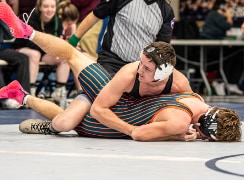Rest assured, but stay insured
Sports seasons are ‘worry’ seasons for parents and coaches alike
As Fall football season creeps closer and everyone starts wondering just how big of a grill is TOO big for a tailgate party, the parents of student athletes begin their season of worrying.
Is this the year they tear their ACL? Is this the year that nagging shoulder finally gives out and they have to have surgery? Their ankle’s a little unstable, will they roll it while they’re running? The worry is worst for those who have children in contact sports, such as football and wrestling, or high-injury sports, such as basketball, but most parents have it to some degree.
Which sports have the highest injury rates really, though? And how much of that is skewed by professional athletes being monsters on the field compared to high school athletes?
According to a study by UC Denver that analyzed the rate of injury among high school students in the 2016-2017 school year, the sport most likely to result in injury was football, with 3.56 boys being injured for every 1,000 players. The second most likely, though, wasn’t rugby or wrestling, but actually girls’ soccer, with an injury rate of 2.46 girls for every 1,000 players.
The most common injury for football players was, unsurprisingly, concussions, causing 27.6-percent of the total injuries, followed by ankle and knee strains respectively. Curiously, 0.1-percent of the injuries to football players were caused by them running into goalposts.
Girls’ soccer players, contrary to what one might assume, are also plagued by concussions, which made up 33.2-percent of the total injuries. Following concussions, the most likely injuries to occur were ankle strains and upper leg injuries.
Injuries to the lower body made up the majority of injuries across the board, totaling 29.8-percent.
Other interesting findings were that, across the board, significantly more injuries occurred in the second hour of practice and the second half of games. With injuries that occurred during practice, as many as 75-percent occurred during the second hour, with the figure hovering between 50-75. With injuries that occurred during competition play, close to 50-percent occurred during the second half, and that stayed true across all sports surveyed.
Finally, the rate of diagnosed concussions has risen from 9.1-percent of total sports-related injuries in the 2005-2006 school year, to just over 24.8-percent in the 2016-2017 school year.
Coach Jason Hamock of the Clinton Dragons, said that knees and concussions are their biggest worries.
“We see a lot of meniscus problems and I think a lot of that is just kids not doing their flexibility training like they should. That, and using too much weight when they’re working out. They put too much weight on when they should be doing lower weight with higher reps and then they end up hurting themselves,” he said.
“Once a kid even has the slightest symptoms [of a concussion],” he continued, “they’re sent to the trainer and if they’re diagnosed, they have to go through the whole process and be released by a physician before they can play again.”
Gary Terry said that, for Anderson County, it’s the shoulders that get them.
“For football it’s the shoulders, but all sports, it’s the ankle injuries that get [the students] the most.” Similar to Coach Hamock, Coach Terry stressed the importance of staying hydrated and not overdoing it during weightlifting.
“It’s probably the biggest thing. If you’re not hydrated, you’re much more likely to pull a muscle or tear something or get injured, so it’s super important. Our strength trainer works with all our kids and builds programs for them and holds them accountable so they’re not in there trying to squat 600 pounds when they just can’t.”
The Tennessee Secondary School Athletic Association sets safety standards and best practices for high schools sports throughout the state. One rule instituted in recent years is that all schools have to have defibrillators in the case of sudden cardiac arrest. Coaches have to be trained in their use and have a developed plan in place in the case of such an event happening.
“You wouldn’t believe the amount of kids with heart issues that are cleared to play athletics, and don’t get me wrong, they should be if they feel up to it. We still have to be ready for it in case something happens. We all have training sessions and action plans about who is supposed to do what. You don’t want to be figuring things out when that happens, because that could cost someone their life.”
Both coaches agreed that it’s important for parents to be involved and educated too.
“It’s just as important that they know the symptoms and we’re all on the same page,” said Terry.
Now all of this probably hasn’t helped any worrying parents, but to put things in perspective, only 7.1-percent of the injuries recorded across the entire school year in all sports required surgery, which means 92.9-percent did not. Add to that the fact that 42-percent of high school athletes injured in competitive play and 55-percent of students injured in practice missed playing for less than ten days, and suddenly the picture doesn’t look so grim. Athletes get injured. It’s sort of their thing. In fact, some athletes seem to lurch from one injury to the next. The alternative, though, is giving up the sport they love, and for plenty of athletes, that’s not a choice at all.

